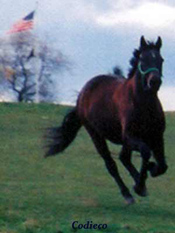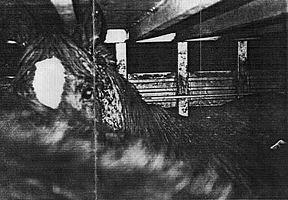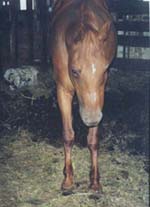
State Statutes Police Horses

This page of our website has statutes regarding police horses and is
dedicated to the memory of Brigadier. Brigadier a member
of the Toronto Police Services was killed in the line
of duty on February 24, 2006.
Our heart goes out to the
loved ones and friends of Brigadier,
the Toronto Police Service horse who was brutally run
down and killed in the line of duty
on February 24, 2006.
We hope those working to change/create laws to protect
Police Animals in Canada are successful.
Please visit Anne's Blog with beautiful
photos and tributes to Brigadier:
1997-2006
"Dirk Sankersingh quietly pled out on January 15, 2007, & received
a 2-year "conditional sentence", i.e. house arrest. What a travesty.
We should all be outraged."
Getting Involved
- Learn your state's laws.
- What horse organizations in your state represent the horses industry in the state legislature?
- Do they represent you on horse welfare issues? Many state horse councils are in favor of horse slaughter and do not take a strong stand on the enforcement of anti-cruelty laws as they apply to horses.
- If the horse industry organizations in your state do not represent your views on horse slaughter and horse welfare, write to your state representatives and let them know that these organizations do NOT represent you, a member of the horse industry, on this issue.
- Inform the horse organizations that you are a member of that you are
opposed to the use of double cattle trailers to transport horses & opposed
to the slaughter of horses for human consumption.
Reading a Statute
- Look for the Definitions - This section will tell you what animals
are covered under the statute and define certain terms.
- Look for Penalties- This section tells you what the
penalty is for a person convicted of the offense.
It also tells you whether or not the penalties are Civil
or Criminal. Criminal penalties can be enforced by
police departments. Civil Penalties do not allow for
imprisonment. Usually the penalty involves monetary
damages.
- Look for Authority- This section will tell you what law
enforcement agency or agencies have jurisdiction. In other
words, who can enforce the law.
Look for Sections - The sections will
describe the act(s) which are illegal.
Resources for State Laws Regarding Horses
Horse Statutes
This site is an excellent resource for statutes and cases
regarding all animals.
State
Statute
California
Penal Code 600
(a) Any person who willfully and maliciously and with
no legal justification strikes beats, kicks, cuts,
stabs, shoots with a firearm, administers any poison
or other harmful or stupefying substance to, or throws,
hurls, or projects at, or places any rock, object,
or other substance which is used in a manner as to
be capable of producing injury and likely to produce
injury, on or in the path of, any horse being used
by, or any dog under the supervision of, any peace
officer in the discharge or attempted discharge of
his or her duties, is guilty of a public offense. If
the injury inflicted is a serious injury, as defined
in subdivision (c), the person shall be punished by
impreisonment in the state prison for 16 months, two
or three years, or in a county jail for not exceeding
one year, or by a fine not exceeding two thousand dollars
($2000.00), or by both a fine and imprisonment. If
the injury inflicted is not a serious injury, the person
shall be punished by imprisonment in the county jail
for not exceeding one year, or by a fine not exceeding
one thousand $(1000.00), or by both a fine and imprisonment.
(b) Any person who wilfully and maliciously and with
no legal justification interferes with or obstructs
any horse or dog being used by any peace officer in
the discharge or attempted discharge of his or her
duties by frightening, teasing, agitating, harassing,
or hindering the horse or dog shall be punished by
imprisonment in a county jail for not exceeding one
year, or by a fine not exceeding one thousand ($1000.00),
or by both a fine and imprisonment.
(c) Any person who, in violation of this section, and
with intent to inflict such injury or death, personally
causes the death, destruction, or serious physical
injury including bone fracture, loss or impairment
of function of any bodily member, wounds requiring
extensive suturing, or serious crippling, of any horse
or dog, shall, upon conviction of a felony under this
section, in addition and consecutive to the punishment
prescribed for the felony, be punished by an additional
term of imprisonment in the state prison for one year.
(d) Any person who, in violation of this section, and
with the intent to inflict such injury, personally
causes great bodily injury, as defined in Section 12022.7,
to any person not an accomplice, shall upon conviction
of a felony under this section, in addition and consecutive
to the punishment prescribed for the felony, be punished
by an additional term of imprisonment in the state
prison for two years unless the conduct described in
this subdivision is an element of any other offense
of which the person is convicted or receives an enhancement
under Section 12002.7.
(e) In any case in which a defendant is convicted of
a violation of this section, the defendant shall be
ordered to make restitution to the agency owning the
animal and employing the peace officer for any veterinary
bills, replacement costs of the animal if it is disabled
or killed, and the salary of the peace officer for
the period of time his or her services are lost to
the agency.
Leg.H. 1984 ch. 443. effective July 12, 1984, 1985
chs. 106, 765.
1984 Note: the Legislature inserted a cross-reference
to Penal Code Section 12002.7 in subdivision (d) by
Stats. 1984 ch. 443. However, the cross-reference is
to a section that does not exist.
Connectiticut
§ 53-247. Cruelty to animals.
Fighting animals. Intentional killing of police animals
or dogs in volunteer canine search and rescue teams
(e) Any person who intentionally kills any animal
while such animal is in the performance of its duties
under the supervision of a peace officer, as defined
in section 53a-3, or intentionally kills a dog that
is a member of a volunteer canine search and rescue
team, as defined in section 5-249, while such dog
is in the performance of its duties under the supervision
of the active individual member of such team, shall
be fined not more than ten thousand dollars or imprisoned
not more than ten years or both.
Indiana
35-43-1-2 Mischief
A person who: Recklessly, knowingly, or intentionally damages or
defaces property of another person without the other person's consent;
or Knowingly or intentionally causes another to suffer pecuniary
loss by deception or by an expression of intention to injure another
person or to damage the property or yo impair the rights of another
person; commits criminal mischief a class B misdemeanor. However
the offense is: (B) a class D felony if (v) the damage is to a law
enforcement animal as defined in 35-46-3-4.5. ( 1 1/2 years/$10,000
+ or -) We also have 35-46-3-11. Striking, Interfering with a law
enforcement animal. This is a class A Misdemeanor (1 year/$5,000
+ or -)
Massachusetts
General Law
MGL
272 Sec 77A: Willfully injuring police dogs and horses
Whoever
willfully tortures, torments, beats, kicks, strikes,
mutilates, injures, disables, or otherwise mistreats,
a dog or horse owned by a police department or police
agency of the commonwealth or any of its political subdivisions
or whoever, willfully by any action whatsoever, interferes
with the lawful performance of such dog or horse shall
be punished by a fine of not less then one hundred dollars
and not more than five hundred dollars or by inprisonment
for not more than two and one-half years or both. Persons
violating this section may be arrested without a warrant
by any officer qualified to serve criminal process provided
said offense is committed in his presence. (simple misdemeanor)
Nebraska
28-1009 Abandonment; cruelty; harassment of a
police animal; penalty.
(3) A person commits harassment of a police animal if
he or she knowingly and intentionally teases or harasses
a police animal in order to distract, agitate, or harm
the police animal for the purpose of preventing such animal
from performing its legitimate official duties. Harassment
of a police animal is a Class IV misdemeanor unless the
harassment is the proximate cause of the death of the police
animal, in which case it is a Class IV felony.
Nevada
574.105. Mistreatment of police animal and interference
with duties of police animal or handler unlawful; penalty;
exception
1. A person shall not willfully and maliciously:
(a) Taunt, torment, tease, beat, strike or administer a
desensitizing drug, chemical or substance to a police animal;
(b) Interfere with a police animal or a handler thereof
in the performance of duties assigned to the police animal
or handler; or
(c) Torture, mutilate, injure, poison, disable or kill
a police animal.
2. A person who violates:
(a) Paragraph (a) or (b) of subsection 1 is guilty of a
category D felony and shall be punished as provided in
NRS 193.130.
(b) Paragraph (c) of subsection 1 is guilty of:
(1) If the police animal is not totally disabled or killed,
a category D felony and shall be punished as provided
in NRS 193.130, and may be further punished by a fine of
not more than $10,000.
(2) If the police animal is totally disabled or killed,
a category C felony and shall be punished as provided in
NRS 193.130. In addition to the punishment imposed pursuant
to this subparagraph, the court may require a person who
is punished pursuant to this subparagraph to pay restitution
to the agency that owns the police animal, including, without
limitation, payment for veterinary services and the cost
of replacing the police animal.
3. The provisions of this section do not prohibit a euthanasia
technician licensed pursuant to chapter 638 of NRS, a peace
officer or a veterinarian from euthanizing a police animal
in an emergency if the police animal is critically wounded
and would otherwise endure undue suffering and pain.
New
Jersey
2C:29-3.1. Animal owned, used by law enforcement
agency, infliction of harm upon, interference with officer, degree of
crime, penalties:
1.Any person who purposely kills a dog, horse or other animal owned
or used by a law enforcement agency shall be guilty of a crime of the
third degree. Any person who purposely maims or otherwise inflicts
harm upon a dog, horse or other animal owned or used by a law enforcement
agency shall be guilty of a crime of the fourth degree. Any person
who interferes with any law enforcement officer using an animal in
the performance of his official duties commits a disorderly persons
offense, subject to a sentence of six months' imprisonment, some or
all of which may be community service, restitution and a $1,000.00
fine.
L.1983,c.261,s.1; amended 1999, c.14.
Ohio Revised Code 2921.32.1.
No person shall knowingly cause or attempt to cause physical
harm to a police dog or horse in either of the following,if the
dog or horse is assisting a police officer in doing his official
duties or the dog or horse is not assisting the officer but the
offender has actual knowledge that the dog/horse is a police dog
or police horse. This statute also covers handicapped assistance
dogs. A violation of this statute where death results it is a Felony
of the 4th degree( 6 months to 18 months in jail and a $5,000 fine
). Serious physical harm to the dog/horse it's a Felony of the
5th degree (6 months to 12 months and $2,500 fine ). Physical harm
is a Misdemeanor of the 1st degree ( no time to 6 months & $1,000 fine). If no harm is involved it is a Misd of the
2nd degree ( no time to 90 days & $750 fine )
9.62 Purchase of police dog or horse.
(A) As used in this section:
(1) “Police dog or horse” means a dog or horse that
has been trained, and may be used, to assist law enforcement
officers in the performance of their official duties.
(2) “Law enforcement agency” means an organization
or unit made up of law enforcement officers as defined in section
2901.01 of the Revised Code.
(B) Upon the disbanding of the canine or equine unit of a law
enforcement agency, the agency shall give the law enforcement
officer to whom a police dog or horse is assigned the first chance
to purchase the animal, for one dollar. An officer who purchases
an animal under this section shall assume all responsibility
for the animal thereafter.
(C) If a police dog or horse is injured in the line of duty,
becomes disabled and is unfit for duty, or grows too old to be
fit for duty, the law enforcement officer to whom the animal
is assigned may purchase the animal, for one dollar. If an officer
chooses not to purchase an animal as authorized by this division
or division (B) of this section, the disposition of the animal
shall be as otherwise provided by law.
(D) A law enforcement officer who leaves an equine or canine
unit of a law enforcement agency while the police dog or horse
assigned to the officer is still fit for duty forfeits the right
to purchase the animal under this section.
Effective Date: 06-01-1998
Oregon
ORS 164.369
Interfering with Police Animal.
(1) A person commits the crime of interfering with a police animal
if the person intentionally or knowingly injures or attempts to injure
an animal the person knows or should reasonalbly know is a police animal
while the police animal is being used in the lawful discharge of its
duty.
(2) Interference with a police animal is a class A misdemeanor.
ORS 164.365 Criminal Mischief I
(1) A person commits the crime criminal mischief in the first degree
who, with the intent to damage property, and having now right to do
so nor reasonable ground to believe that the person has such a right:(a)
Damages or destroys property of another:
(F) Which is a police animal and the police animal suffers death or
serious physical injury;( there are several other sub paragraphs that
are included in this statute but this is the one that is applicable
to police animals).
(3) Criminal mischief in the first degree is a class C felony.
Rhode Island
4-1-30. Cruelty to police animals.
--
Any person who willfully tortures, torments, beats,
kicks, strikes, mutilates, injures, disables, or
otherwise mistreats any dog or horse owned by a police
department of this state or any of its political
subdivisions or who willfully by any action interferes
with the lawful performance of a police dog or horse
shall be punished by a fine of not less than one
hundred dollars ($100) and not more than five hundred
dollars ($500), or by imprisonment for not more than
one year, or both.
History of Section.
P.L. 1980, ch. 185, § 1.
Utah
76-9-306. Police service animals -- Causing
injury or interfering with handler --
Penalties.
(1) As used in this section:
(a) "Handler" means a law enforcement officer who
is specially trained, and uses a police service animal
during the course of the performance of his law enforcement
duties.
(b) "Police service animal" means any dog or horse
used by a law enforcement agency, which is specially
trained for law enforcement work, or any animal contracted
to assist a law enforcement agency in the performance
of law enforcement duties.
(2) It is a class A misdemeanor for a person to intentionally:
(a) cause bodily injury or death to a police service
animal;
(b) engage in such conduct likely to cause bodily
injury or death to a police service animal;
(c) lay out, place, or administer any poison, trap,
substance, or object which is likely to produce bodily
injury or death to a police service animal; or
(d) offer or agree with one or more persons to engage
in or cause the performance of an act which constitutes
a violation of this statute.
(3) It is a class B misdemeanor for a person to intentionally
or knowingly:
(a) taunt, torment, strike, or otherwise assault
a police service animal;
(b) throw any object or substance at, or in the path
of, a police service animal;
(c) interfere with or obstruct a police service animal,
or attempt to, or interfere with the handler of the
animal in such a manner as to inhibit, restrict,
or deprive the handler of his control of the animal;
(d) release a police service animal from its area
of control, such as a vehicle, kennel, or pen, or
trespass in that area; or
(e) place any food, object, or substance into a police
service animal's area of control without the permission
of the handler.
(4) A police service animal is exempt from quarantine
or other animal control ordinances if it bites any
person while under proper police supervision or routine
veterinary care. The law enforcement agency and the
animal's handler shall make the animal available
for examination at any reasonable time and shall
notify the local health officer if the animal exhibits
any abnormal behavior.
(5) In addition to any other penalty, a person convicted
of a violation of this section is liable to the owning
or employing law enforcement agency or individual
owner of the police service animal for the replacement,
training, and veterinary costs incurred as a result
of the violation of this section.
Liability
18-1-1. Liability of owners -- Scienter -- Dogs used
in law enforcement. Every person owning or keeping
a dog shall be liable in damages for injury committed
by such dog, and it shall not be necessary in any
action brought therefor to allege or prove that such
dog was of a vicious or mischievous disposition or
that the owner or keeper thereof knew that it was
vicious or mischievous; but neither the state nor
any county, city, or town in the state nor any peace
officer employed by any of them shall be liable in
damages for injury committed by a dog when: (1) The
dog has been trained to assist in law enforcement,
and (2) the injury occurs while the dog is reasonably
and carefully being used in the apprehension, arrest,
or location of a suspected offender or in maintaining
or controlling the public order.







